Designing Urban Spaces to Enhance Active and Sustainable Mobility: An Analysis of Physical and Symbolic Affordances in School Squares in the Metropolitan Area of Milan, Italy
Abstract
1. Introduction
2. Literature Review
2.1. Affective Responses and Affordances in the Urban Environment
2.2. Active School Travel
3. Materials and Methods
3.1. The Sample
3.2. Methodology
- Phase 1—type of school squares: localization and classification of the school squares according to their geometry and functions. The identification of these four different types of school squares is quite innovative, since, to our knowledge, there exists no previous reference on this topic in other works (similar classifications on the typology of spaces have been presented for schoolyards, namely, for the playground spaces inside a school [66,67,68]).
- Phase 2—physical affordances: identification of the spatial features and characteristics that might directly favor or hinder active mobility practices.
- Phase 3—symbolic affordances: identification of the elements and characteristics that might induce different affective responses towards the school square and, consequently, influence mobility choices.
- Type A—park or pedestrian area: large and protected place entirely dedicated to pedestrians, with greenery, seats, and other services where children can move and play freely, for example, an urban park, the main square of a municipality, or an entire road closed to traffic. In this type of school square, we can find the highest attention paid to the quality and to the design for pedestrian use: Such places appear welcoming to parents and their children and encourage them to walk or cycle to school.
- Type B—lay-by: punctual widening of the sidewalk in correspondence with the school entrance, for example, a “peninsula” facing the road or an indentation obtained from setbacks of buildings with a variety of shapes, sizes, and paving. In some cases, a lay-by is furnished with benches, playgrounds, or vegetation. This widening of the sidewalk functions as a symbolic affordance that communicates to the city the importance of the school square, since in this setting children and their parents are able to affirm their presence through lingering. Nevertheless, planners should remember the necessity of evaluating the size of the lay-by in relation to the number of pupils attending the school.
- Type C—sidewalk: This school square develops in a linear manner, almost following the flow of movements that pupils produce in order to reach the school entrance. Unlike the lay-by, the sidewalk is independent of the presence of the school and acts as a transit space rather than an area in which to linger: It has been noted that a sidewalk does not offer enough space when pupils and parents crowd in front of the entrance, often leading to occupying part of the road and thus reducing their sense of safety.
- Type D—car park: public car park used by other citizens or specific areas within the school complex with access regulated by gates separating the road. The presence of a car park as a school square can be interpreted from two different points of view. On one hand, a car park might be perceived by parents and school staff as an element of convenience for reaching school, since in a certain sense it frees streets and sidewalks from “wild parking.” On the other hand, it might be perceived as a problematic element. In fact, an area full of cars reduces the overall sense of safety and subtracts space from pedestrians, especially if rush hour coincides with the period in which pupils frequent the area. It was noted that in addition to the many negative aspects caused by traffic (e.g., danger, noise and environmental pollution, visual barrier, etc.), a car park functions as a (negative) symbolic affordance, encouraging the use of private cars and communicating a distorted cultural message, according to which the car is the “natural” way to get to school.
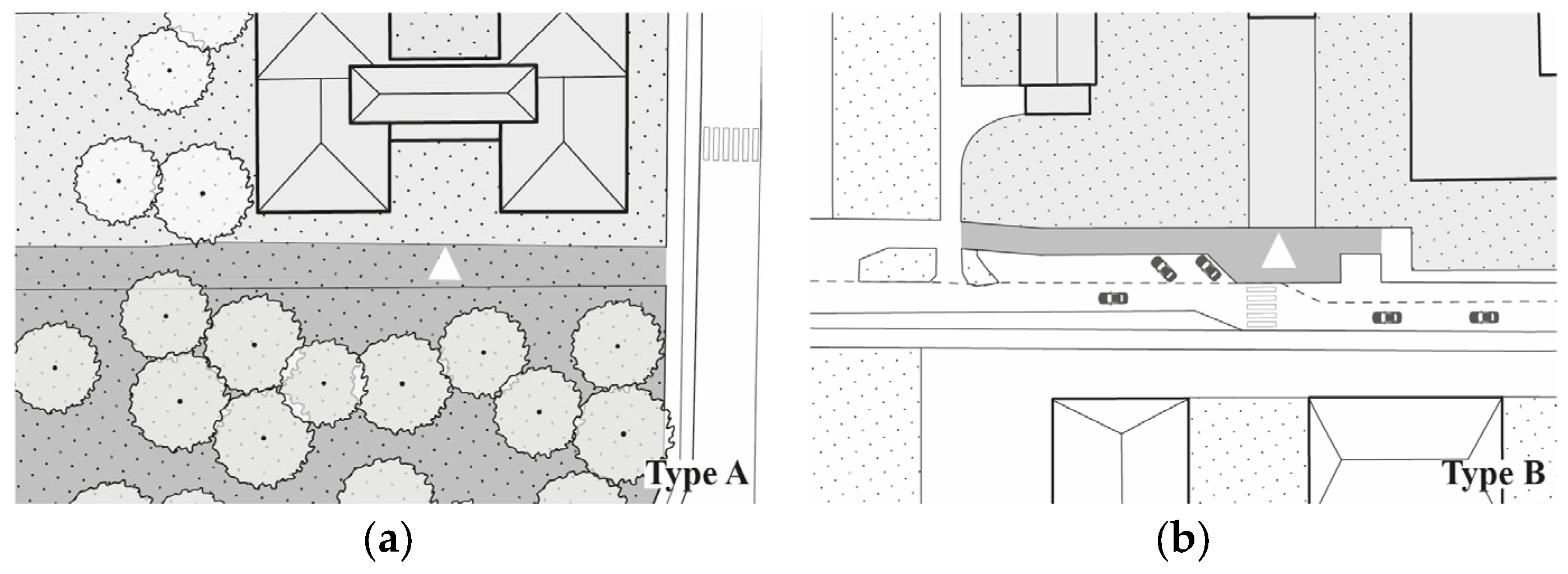
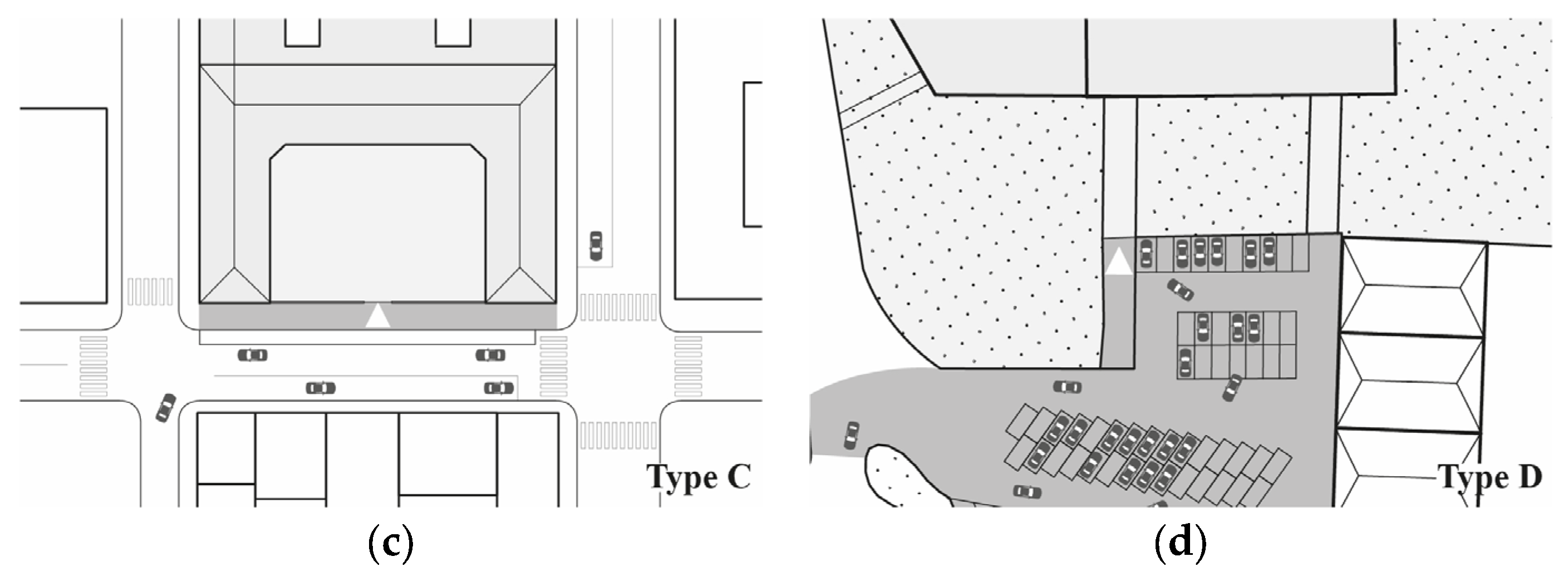
- Bicycle rack: embodies the concept of sustainable mobility because it provides pupils with a space to leave their bicycles while they are at school.
- Protective barrier: could favor active mobility protecting schoolchildren from the traffic of the street and make walking to school safer.
- Bench: encourages walking to school, providing the chance to rest and socialize with other people. It favors the possibility of experiencing a place slowly on foot or by bike, rather than just passing it to get in the car.
- Parked cars: make it more difficult and dangerous to go to school on foot or by bike. In addition to hindering active mobility, the presence of cars also lowers the quality of a school square, negatively influencing the affective perception that pupils have of this place.
- Greenery: The presence of trees, hedges, bushes, flowers, or flower beds was mapped within the sample area, assuming that greenery positively affects the walk to school and the permanence in a school square.
- Dustbin: a recurring element in school squares. Although schools need to manage a large amount of waste, placing it at the entrance gate has a negative influence on the affective perception of that place.
| Feature | Physical Affordances | Symbolic Affordances |
|---|---|---|
| Bicycle rack (+) | ✓ | ✓ |
| Protective barrier (+) | ✓ | |
| Bench (+) | ✓ | |
| Parked cars (−) | ✓ | ✓ |
| Greenery (+) | ✓ | |
| Dustbin (−) | ✓ |
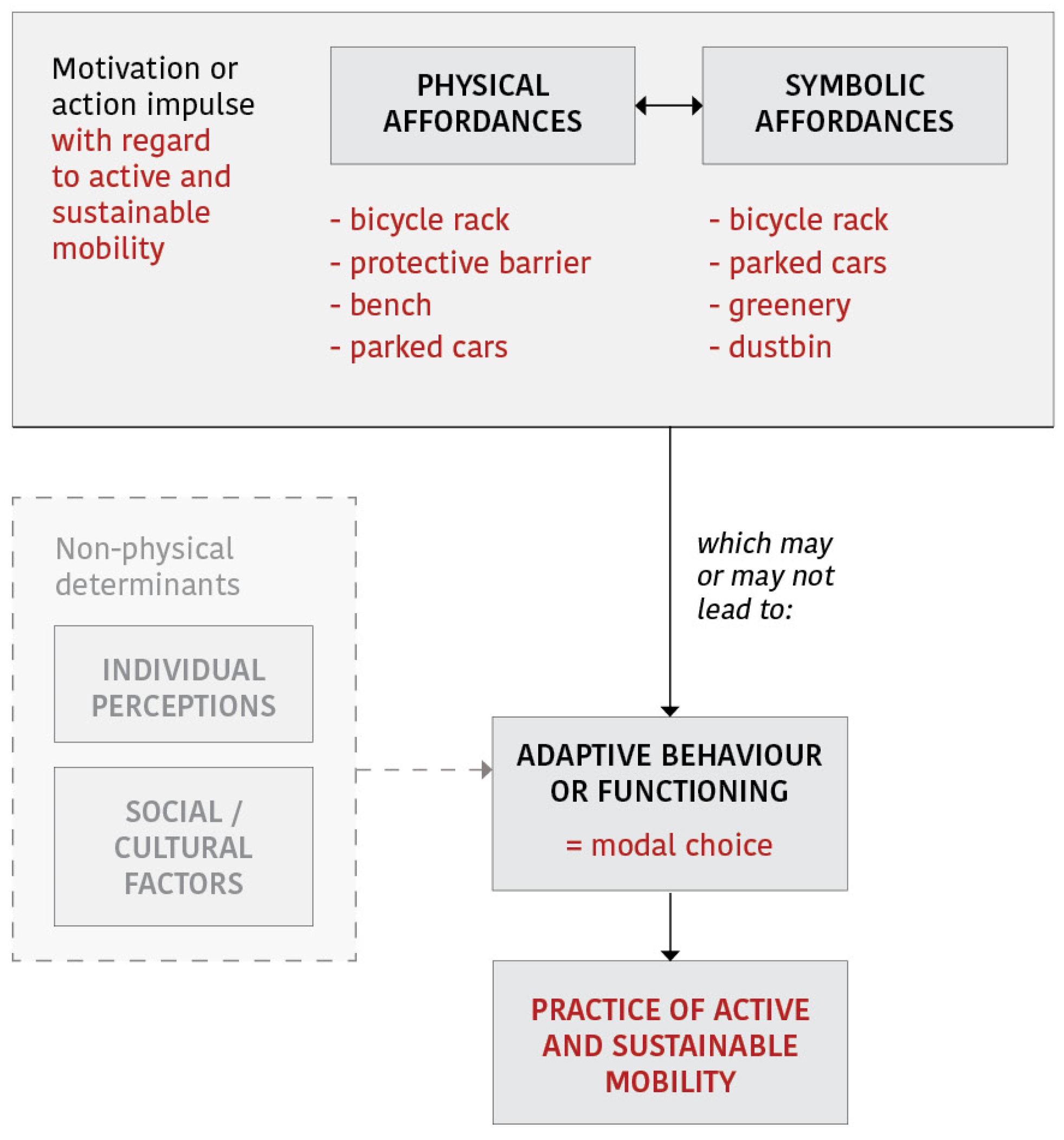
4. Results
4.1. Phase 1—Type of School Squares
- Type A—parks and pedestrian areas, articulated as school squares, were found to have the least frequency in the study sample: 12% of the cases, with 20 schools in Milan and 30 schools outside Milan.
- Type B—lay-bys were more widespread in the municipalities around Milan and in those to the east (75 cases out of 198 outside Milan, 67 cases out of 218 in Milan) and accounted for 34% of the cases. The average size of the lay-bys in the sample area is 100 m2, whereas the average number of pupils per school is 340 children: It follows that each child has on average 0.3 m2 of peninsula available (0.15 m2 if we consider the presence of a parent for every child) and that dimensions of lay-bys are often undersized.
- Type C—the sidewalk typology was the most common within the sample area: 40% of cases, equal to 165 schools, with an average width of 2.5 m, and just enough space for two people side by side. Sidewalks were mainly in the city of Milan (115 schools out of 218).
- Type D—in the sample area, school squares in the form of car parks were found above all in urban areas with large availability of space: Out of 59 cases (14% of the total), 16 were in Milan and 43 outside Milan.
4.2. Phase 2—Physical Affordances
- Bicycle rack: found in 47% of cases (105 cases out of 198 outside Milan, 91 cases out of 218 in Milan).
- Protective barrier: found in 49% of cases (58 cases out of 198 outside Milan, 146 cases out of 218 in Milan).
- Bench: found in 29% of cases (79 cases out of 198 outside Milan, 43 cases out of 218 in Milan).
- Parked cars: found in 84% of cases (156 cases out of 198 outside Milan, 195 cases out of 218 in Milan).
4.3. Phase 3—Symbolic Affordances
- Bicycle rack: found in 47% of cases (105 cases out of 198 outside Milan, 91 cases out of 218 in Milan).
- Parked cars: found in 84% of cases (156 cases out of 198 outside Milan, 195 cases out of 218 in Milan).
- Greenery: found in 45% of cases (111 cases out of 198 outside Milan, 74 cases out of 218 in Milan).
- Dustbin: found in 52% of cases (112 cases out of 198 outside Milan, 105 cases out of 218 in Milan).
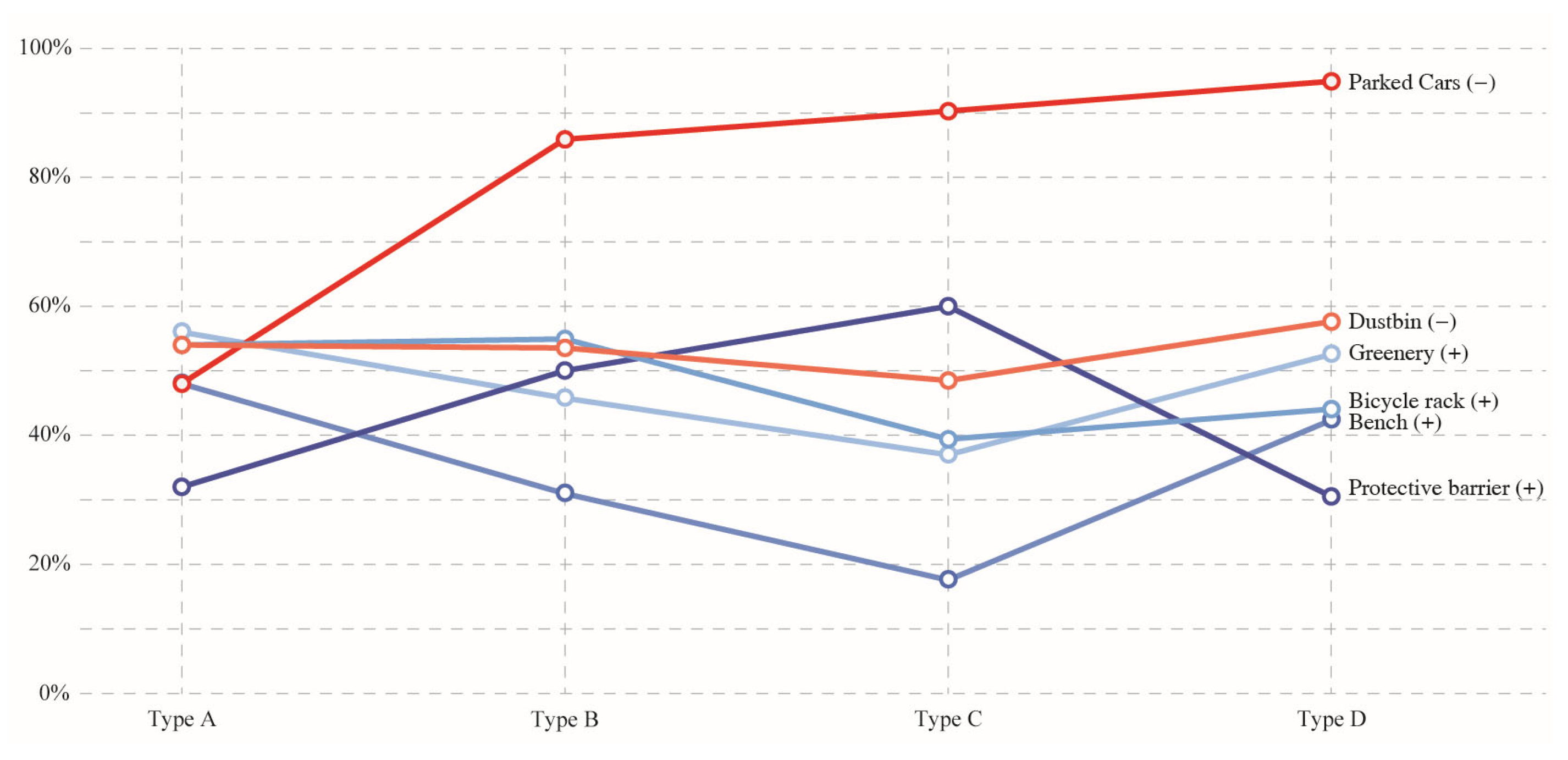
| School Square Type | Bicycle Rack (+) | Protective Barrier (+) | Bench (+) | Parked Cars (−) | Greenery (+) | Dustbin (−) |
|---|---|---|---|---|---|---|
| Type A (park or pedestrian area) | ✓ | ✓ | ✓ | ✓ | ||
| Type B (lay-by) | ✓ | ✓ | ✓ | ✓ | ||
| Type C (sidewalk) | ✓ | ✓ | ✓ | |||
| Type D (car park) | ✓ | ✓ | ✓ | ✓ |
5. Discussion
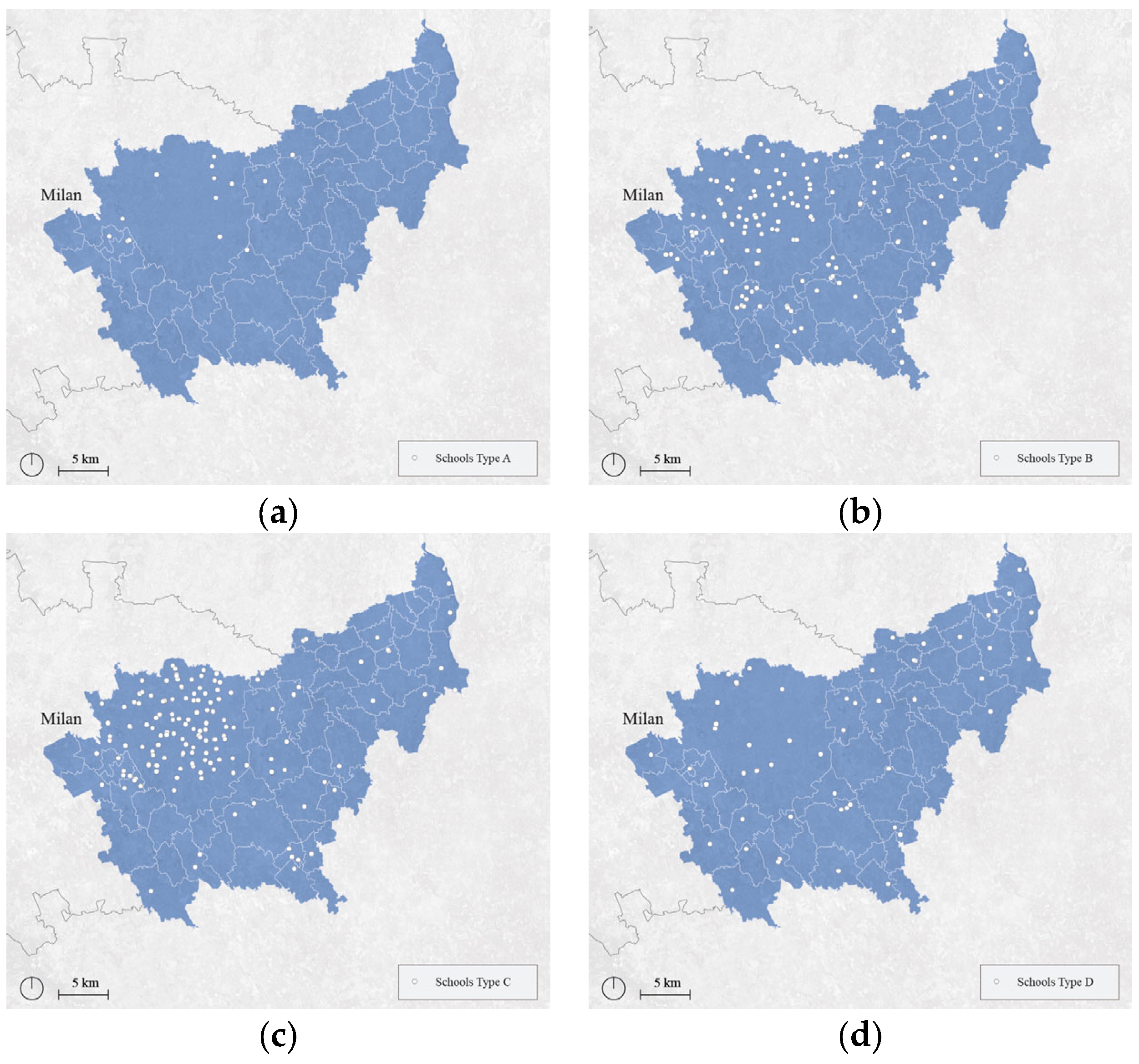

Author Contributions
Funding
Institutional Review Board Statement
Informed Consent Statement
Data Availability Statement
Acknowledgments
Conflicts of Interest
References
- Talen, E.; Koschinsky, J. The Walkable Neighborhood: A Literature Review. Int. J. Sustain. Land Use Urban Plan. 2013, 1, 42–63. [Google Scholar] [CrossRef]
- Forsyth, A. What is a walkable place? The walkability debate in urban design. Urban Des. Int. 2015, 20, 274–292. [Google Scholar] [CrossRef]
- Liang, Y.; D’Uva, D.; Scandiffio, A.; Rolando, A. The more walkable, the more livable?—Can urban attractiveness improve urban vitality? Transp. Res. Procedia 2022, 60, 322–329. [Google Scholar] [CrossRef]
- Scotini, R.; Skinner, I.; Racioppi, F.; Fusé, V.; Bertucci, J.O.; Tsutsumi, R. Supporting Active Mobility and Green Jobs through the Promotion of Cycling. Int. J. Env. Res. Public Health 2017, 14, 1603. [Google Scholar] [CrossRef]
- Maltese, I.; Gatta, V.; Marcucci, E. Active Travel in Sustainable Urban Mobility Plans. An Italian Overview. Res. Transp. Bus. Manag. 2021, 40, 100621. [Google Scholar] [CrossRef]
- Litman, T. Evaluating Active Transport Benefits and Costs—Guide to Valuing Walking and Cycling Improvements and ENCOURAGEMENT Programs. Victoria Transport Institute. 2020. Available online: https://www.vtpi.org/nmt-tdm.pdf (accessed on 5 May 2023).
- Biggar, M. Non-motorized transport: Walking and cycling. In Sustainable Cities and Communities; Filho, W.L., Azul, A., Brandli, L., Ozuyar, P., Wall, T., Eds.; Springer: Cham, Switzerland, 2020. [Google Scholar] [CrossRef]
- European Commission. Sustainable Urban Transport Plans. Preparatory Document in Relation to the Follow-Up of the Thematic Strategy on the Urban Environment; main document—Technical report; European Commission: Brussels, Belgium, 2007; Volume 018. [Google Scholar]
- Assunçao-Denis, M.E.; Tomalty, R. Increasing cycling for transportation in Canadian communities: Understanding what works. Transp. Res. Part A Policy Pract. 2019, 123, 288–304. [Google Scholar] [CrossRef]
- Iroz-Elardo, N.; Schoner, J.; Fox, E.H.; Brookes, A.; Frank, L.D. Active travel and social justice: Addressing disparities and promoting health equity through a novel approach to Regional Transportation Planning. Soc. Sci. Med. 2020, 261, 113211. [Google Scholar] [CrossRef]
- Neun, M.; Cortesi, G.; Cox, P.; Neun, M.; Sabelis, I.; Held, M.; Kesselring, S. ‘Prioritizing Active Mobility’: A Report and Recommendations Arising from ESOF 2020 Addressing the EU Commission on the European Strategy for a Sustainable and Smart Mobility. 2020. Available online: https://transformateure.org/wp-content/uploads/Publikationen/2020-15__EGD_fback_report2.pdf (accessed on 5 May 2023).
- Neun, M. Framing sustainable mobility in practice and research—And rethinking ‘Reverse Innovation’ in the case of Active Mobility. In Framing the Third Cycling Century—Bridging the Gap between Research and Practice; Grafl, K., Bunte, H., Dziekan, K., Haubold, H., Neun, M., Eds.; UBA German Environment Agency: Dessau-Roßlau, Germany; ECF European Cyclist Federation: Brussels, Belgium, 2018. [Google Scholar]
- Ferretto, L.; Bruzzone, F.; Nocera, S. Pathways to active mobility planning. Res. Transp. Econ. 2021, 86, 101027. [Google Scholar] [CrossRef]
- Cerqueira, E.D.V.; Motte-Baumvol, B.; Chevallier, L.B.; Bonin, O. Does working from home reduce CO2 emissions? An analysis of travel patterns as dictated by workplaces. Transp. Res. Part D Transp. Environ. 2020, 83, 102338. [Google Scholar] [CrossRef]
- Wegener, S.; Raser, E.; Gaupp-Berghausen, M.; Anaya, E.; Erikksson, U.; Horvath, I.; Iacorossi, F.; Int Panis, L.; Kahlmeier, S.; Rojas Rueda, D.; et al. Step by step towards healthy cities: How active mobility serves transport and public health. Eur. J. Public Health 2016, 26, ckw165-006. [Google Scholar] [CrossRef]
- Devos, T.; van Acker, M.; Vandevoorde, J.; Rybels, S. Towards a movement-friendly city: Lessons from activity scans of five neighbourhoods in Antwerp, Belgium. J. Urban Des. 2023, 1–22. [Google Scholar] [CrossRef]
- Laine, J.; Kuvaja-Kollner, V.; Pietila, E.; Koivuneva, M.; Valtonen, H.; Kankaanpaa, E. Cost-effectiveness of population-level physical activity interventions: A systematic review. Am. J. Health Promot. 2014, 29, 71–80. [Google Scholar] [CrossRef] [PubMed]
- Wanner, M.; Gotschi, T.; Martin-Diener, E.; Kahlmeier, S.; Martin, B.W. Active transport, physical activity, and body weight in adults: A systematic review. Am. J. Prev. Med. 2012, 42, 493–502. [Google Scholar] [CrossRef] [PubMed]
- Hackl, R.; Raffler, C.; Friesenecker, M.; Kramar, H.; Kalasek, R.; Soteropoulos, A.; Wolf-Eberl, S.; Posch, P.; Tomschy, R. Promoting active mobility: Evidence-based decision-making using statistical models. J. Transp. Geogr. 2019, 80, 102541. [Google Scholar] [CrossRef]
- Heinen, E.; van Wee, B.; Maat, K. Commuting by bicycle. An overview of the literature. Transp. Rev. 2010, 30, 59–96. [Google Scholar] [CrossRef]
- Pooley, C.G.; Horton, D.; Scheldeman, G.; Tight, M.; Jones, T.; Chisholm, A.; Harwatt, H.; Jopson, A. Household decision-making for everyday travel: A case study of walking and cycling in Lancaster (UK). J. Transp. Geogr 2010, 19, 1601–1607. [Google Scholar] [CrossRef]
- Wang, Y.; Chau, C.K.; Ng, W.F.; Leung, T.M. A review on the effects of physical built environment attributes on enhancing walking and cycling activity levels within residential neighborhoods. Cities 2016, 50, 1–15. [Google Scholar] [CrossRef]
- Carlson, S.A.; Paul, P.; Watson, K.B.; Schmid, T.L.; Fulton, J.E. How reported usefulness modifies the association between neighborhood supports and walking behavior. Prev. Med. 2016, 91, 76–81. [Google Scholar] [CrossRef]
- Fraser, S.; Lock, K. Cycling for transport and public health: A systematic review of the effect of the environment on cycling. Eur. J. Public Health 2021, 21, 738–743. [Google Scholar] [CrossRef]
- Rothman, L.; Howard, A.; Buliung, R.; Macarthur, C.; Richmond, S.; Macpherson, A. School environments and social risk factors for child pedestrian-motor vehicle collisions: A case-control study. Accid. Anal. Prev. 2017, 98, 252–258. [Google Scholar] [CrossRef]
- Ball, K.; Bauman, A.; Leslie, E.; Owen, N. Perceived environmental aesthetics and convenience and company are associated with walking for exercise among Australian adults. Prev. Med. 2001, 33, 434–440. [Google Scholar] [CrossRef] [PubMed]
- Torres, J.; Cloutier, M.S.; Bergeron, J.; St-Denis, A. ‘They installed a speed bump’: Children’s perceptions of traffic-calming measures around elementary schools. Child. Geogr. 2020, 18, 477–489. [Google Scholar] [CrossRef]
- Raffler, C.; Brezina, T.; Emberger, G. Cycling investment expedience. Energy expenditure based Cost-Path Analysis of national census bicycle commuting data. Transp. Res. A Policy Pract. 2019, 121, 360–373. [Google Scholar] [CrossRef]
- Stewart, O.; Moudon, A.V.; Claybrooke, C. Common ground: Eight factors that influence walking and biking to school. Transp. Policy 2012, 24, 240–248. [Google Scholar] [CrossRef]
- Soltani, A.; Javadpoor, M.; Shams, F.; Mehdizadeh, M. Street network morphology and active mobility to school: Applying space syntax methodology in Shiraz, Iran. J. Transp. Health 2022, 27, 101493. [Google Scholar] [CrossRef]
- Ettema, D.; Smajic, I. Walking, places and wellbeing. Geogr. J. 2015, 181, 102–109. [Google Scholar] [CrossRef]
- Hockey, A.; Phillips, J.; Walford, N. Planning for an ageing society: Voices from the planning profession. Plan. Pract. Res. 2013, 28, 527–543. [Google Scholar] [CrossRef]
- Papageorgiou, G.; Demetriou, G. Investigating learning and diffusion strategies for sustainable mobility. Smart Sustain. Built Environ. 2020, 9, 1–16. [Google Scholar] [CrossRef]
- Waygood, E.O.D.; Friman, M.; Olsson, L.E.; Taniguchi, A. Transport and child well-being: An integrative review. Travel Behav. Soc. 2017, 9, 32–49. [Google Scholar] [CrossRef]
- Bina, M.; Confalonieri, F.; Abati, D.; Villa, D.; Biassoni, F. Analysis of traffic upon school departure: Environment behaviour, well-being and risk factors for road crashes. J. Transp. Health 2021, 22, 10119. [Google Scholar] [CrossRef]
- Johansson, M.; Sternudd, C.; Kärrholm, M. Perceived urban design qualities and affective experiences of walking. J. Urban Des. 2016, 21, 256–275. [Google Scholar] [CrossRef]
- Jacobs, M. Psychology of the Visual Landscape. Res. Urban. Ser. 2011, 2, 41–54. [Google Scholar] [CrossRef]
- Nasar, J.L. The Evaluative Image of the City; Sage Publications: Thousand Oaks, CA, USA, 1998. [Google Scholar]
- Rapoport, A. The Meaning of the Built Environment. A Nonverbal Communication Approach; Sage Publications: Thousand Oaks, CA, USA, 1982. [Google Scholar]
- Russell, J.A. Affective appraisals of environments. In Environmental Aesthetics: Theory, Research, and Applications; Nasar, J.L., Ed.; Cambridge University Press: Cambridge, UK, 1988; pp. 120–129. [Google Scholar]
- Ulrich, R.S. Aesthetic and Affective Response to Natural Environment. In Behavior and the Natural Environment; Altman, I., Wohlwill, J.F., Eds.; Springer: Boston, MA, USA, 1983; Volume 6, pp. 85–125. [Google Scholar] [CrossRef]
- Ewing, R.; Handy, S. Measuring the unmeasurable: Urban design qualities related to walkability. J. Urban Des. 2009, 14, 65–84. [Google Scholar] [CrossRef]
- Gibson, J.J. The Ecological Approach to Visual Perception; Lawrence Erlbaum Associates Publishers: Mahwah, NJ, USA, 1979. [Google Scholar]
- Donnellan, N.; Egli, V.; Smith, M. ‘I’d paint rainbows and unicorns on it’: Understanding children’s school travel behaviours and the impact of a new shared path. J. Transp. Health 2020, 17, 100838. [Google Scholar] [CrossRef]
- Pont, K.; Wadley, D.; Ziviani, J.; Khan, A. The Influence of Urban Form and Family Decision Making on Children’s Travel to School. J. Urban Des. 2013, 18, 363–382. [Google Scholar] [CrossRef]
- Rothman, L.; Hagel, B.; Howard, A.; Cloutier, M.S.; Macpherson, A.; Aguirre, A.N.; McCormack, G.R.; Fuselli, P.; Buliung, R.; HubkaRao, T.; et al. Active school transportation and the built environment across Canadian cities: Findings from the child active transportation safety and the environment (CHASE) study. Prev. Med. 2021, 146, 106470. [Google Scholar] [CrossRef]
- Pileri, P.; Renzoni, C.; Savoldi, P. School Squares. Reinventing the Dialogue between School and City; Corraini: Milan, Italy, 2022. [Google Scholar]
- Ross, N.J. “My journey to school…”: Foregrounding the meaning of school journeys and children’s engagements and interactions in their everyday localities. Child. Geogr. 2007, 5, 373–391. [Google Scholar] [CrossRef]
- Romero, V. Children’s experiences: Enjoyment and fun as additional encouragement for walking to school. J. Transp. Health 2015, 2, 230–237. [Google Scholar] [CrossRef]
- Egli, V.; Mackay, L.; Jelleyman, C.; Ikeda, E.; Hopkins, S.; Smith, M. Social relationships, nature, and traffic: Findings from a child-centred approach to measuring active school travel route perceptions. Child. Geogr. 2020, 18, 667–683. [Google Scholar] [CrossRef]
- Morris, S.; Lawlor, E.R.; Foley, L.; Summerbell, C.; Panter, J.; Adams, J.; Jago, R.; Pollard, T.M. Children’s experiences of the journey between home and school: A qualitative synthesis using meta-ethnography. Health Place 2022, 76, 102819. [Google Scholar] [CrossRef]
- Ward, C. L’educazione Incidentale; Elèuthera: Milan, Italy, 2018. [Google Scholar]
- Gehl, J. Life Between Buildings; Island Press: Washington, DC, USA, 2011. [Google Scholar]
- Wales, M.; Mårtensson, F.; Jansson, M. ‘You can be outside a lot’: Independent mobility and agency among children in a suburban community in Sweden. Child. Geogr. 2021, 19, 184–196. [Google Scholar] [CrossRef]
- Panter, J.R.; Jones, A.P.; van Sluijs, E.M.F. Environmental determinants of active travel in youth: A review and framework for future research. Int. J. Behav. Nutr. Phys. Activ. 2008, 5, 34. [Google Scholar] [CrossRef] [PubMed]
- Smith, M.; Mavoa, S.; Badland, H.M.; Parker, K.; Donovan, P.; Kearns, R.; Lin, E.-Y.; Witten, K. Associations between the neighbourhood built environment and out of school physical activity and active travel: An examination from the Kids in the City study. Health Place 2015, 36, 57–64. [Google Scholar] [CrossRef]
- Smith, M.; Hosking, J.; Woodward, A.; Witten, K.; Macmillan, A.; Field, A.; Baas, P.; Mackie, H. Systematic literature review of built environment effects on physical activity and active transport—An update and new findings on health equity. Int. J. Behav. Nutr. Phys. Activ. 2017, 14, 1–27. [Google Scholar] [CrossRef]
- Gehl, J. Cities for People; Island Press: Washington, DC, USA, 2010. [Google Scholar]
- Snyder, G. Mountains and Rivers without End; Counterpoint Press: Berkeley, CA, USA, 1996. [Google Scholar]
- Casagrandi, R.; Pileri, P. HABITAT@SCUOLA. Qualità Degli Spazi Urbani Davanti Alle Scuole. Oasi di Biodiversità Dentro le Scuole; Altreconomia: Milan, Italy, 2020; Available online: www.habitatscuola.polimi.it (accessed on 11 May 2023).
- Villanueva, K.; Giles-Corti, B.; Bulsara, M.; Trapp, G.; Timperio, A.; McCormack, G.; van Niel, K. Does the walkability of neighbourhoods affect children’s independent mobility, independent of parental, socio-cultural and individual factors? Child. Geogr. 2014, 12, 393–411. [Google Scholar] [CrossRef]
- ARUP. Cities Alive. Designing for Urban Childhoods; ARUP: London, UK, 2017. [Google Scholar]
- Salducco, A.; Abati, D.; Bina, M.; Bertani, B.; Calarco, S.; Balzarotti, S.; Biassoni, F. Young pedestrians’ behaviours and risk perception: A pilot study with Italian early adolescents. Transp. Res. Part F Traffic Psychol. Behav. 2022, 90, 512–523. [Google Scholar] [CrossRef]
- Regione Lombardia. Mappa Istituzioni Scolastiche e Scuole Statali. Available online: https://www.dati.lombardia.it/Istruzione/Mappa-istituzioni-scolastiche-e-scuole-statali/bf55-y6y4 (accessed on 11 May 2023).
- Portale Unico dei Dati della Scuola. Catalogo Dataset Ambito Scuola. Available online: https://dati.istruzione.it/opendata/opendata/catalogo/elements1/?area=Studenti (accessed on 11 May 2023).
- Andersen, H.B.; Klinker, C.D.; Toftager, M.; Pawlowski, C.S.; Schipperijn, J. Objectively measured differences in physical activity in five types of schoolyard area. Landsc. Urban Plan. 2015, 134, 83–92. [Google Scholar] [CrossRef]
- Allender, S.; Cowburn, G.; Foster, C. Understanding participation in sport and physical activity among children and adults: A review of qualitative studies. Health Educ. Res. 2006, 21, 826–835. [Google Scholar] [CrossRef]
- Anthamatten, P.J.; Brink, L.; Kingston, B.; Kitchman, E.; Lampe, S.; Nigg, C. An assessment of schoolyard features and behavior patterns in children’s utilization and physical activity. J. Phys. Act. Health 2015, 11, 564–573. [Google Scholar] [CrossRef]
- Anable, J.; Gatersleben, B. All work and no play? The role of instrumental and affective factors in work and leisure journeys by different travel modes. Transp. Res. Part A Policy Pract. 2005, 39, 163–181. [Google Scholar] [CrossRef]
- Cittadini per L’aria. Available online: www.cittadiniperlaria.org (accessed on 11 May 2023).
- Farinelli, F. L’invenzione della Terra; Sellerio: Palermo, Italy, 2007. [Google Scholar]
- Bourke, J. Children’s experiences of their everyday walks through a complex urban landscape of belonging. Child. Geogr. 2017, 15, 93–106. [Google Scholar] [CrossRef]
- Derr, V.; Simons, J. A review of photovoice applications in environment, sustainability, and conservation contexts: Is the method maintaining its emancipatory intents? Environ. Educ. Res. 2019, 26, 359–380. [Google Scholar] [CrossRef]
- Templeton, T.N. ‘That street is taking us to home’: Young children’s photographs of public spaces. Child. Geogr. 2020, 18, 1–15. [Google Scholar] [CrossRef]
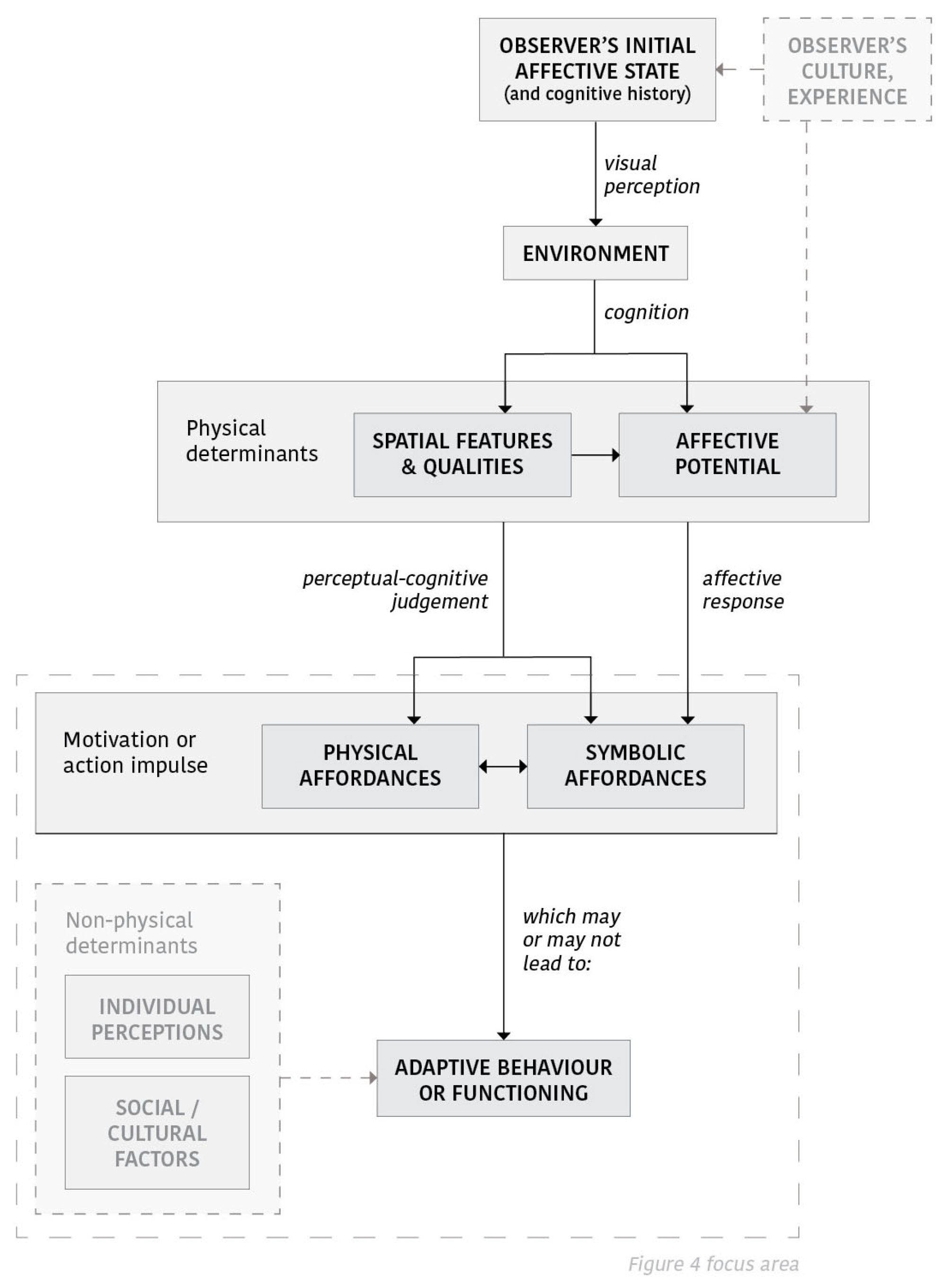
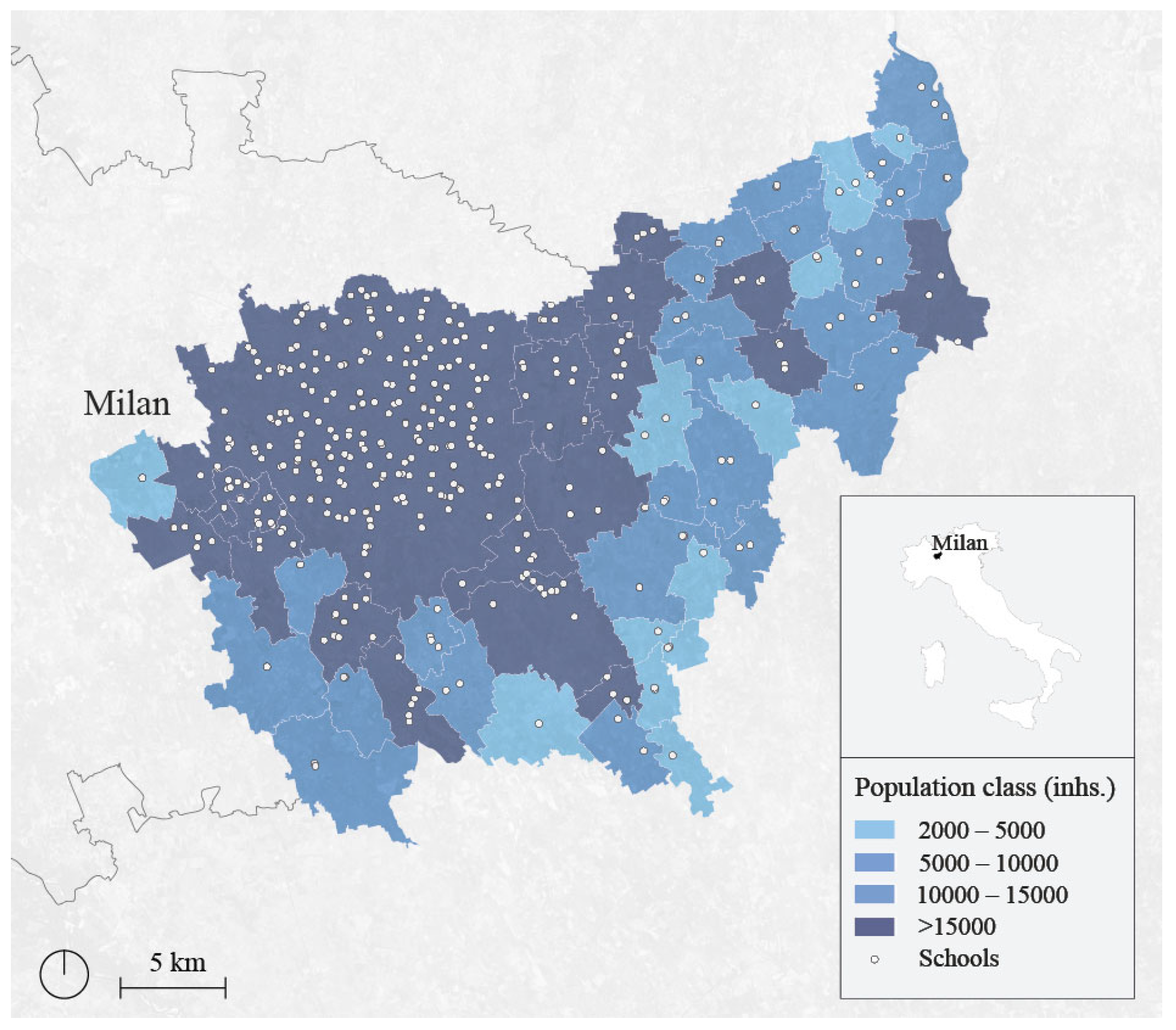
Disclaimer/Publisher’s Note: The statements, opinions and data contained in all publications are solely those of the individual author(s) and contributor(s) and not of MDPI and/or the editor(s). MDPI and/or the editor(s) disclaim responsibility for any injury to people or property resulting from any ideas, methods, instructions or products referred to in the content. |
© 2023 by the authors. Licensee MDPI, Basel, Switzerland. This article is an open access article distributed under the terms and conditions of the Creative Commons Attribution (CC BY) license (https://creativecommons.org/licenses/by/4.0/).
Share and Cite
Bianchi, F.; Riga, D.; Moscarelli, R.; Pileri, P. Designing Urban Spaces to Enhance Active and Sustainable Mobility: An Analysis of Physical and Symbolic Affordances in School Squares in the Metropolitan Area of Milan, Italy. Sustainability 2023, 15, 11328. https://doi.org/10.3390/su151411328
Bianchi F, Riga D, Moscarelli R, Pileri P. Designing Urban Spaces to Enhance Active and Sustainable Mobility: An Analysis of Physical and Symbolic Affordances in School Squares in the Metropolitan Area of Milan, Italy. Sustainability. 2023; 15(14):11328. https://doi.org/10.3390/su151411328
Chicago/Turabian StyleBianchi, Federica, Dafni Riga, Rossella Moscarelli, and Paolo Pileri. 2023. "Designing Urban Spaces to Enhance Active and Sustainable Mobility: An Analysis of Physical and Symbolic Affordances in School Squares in the Metropolitan Area of Milan, Italy" Sustainability 15, no. 14: 11328. https://doi.org/10.3390/su151411328
APA StyleBianchi, F., Riga, D., Moscarelli, R., & Pileri, P. (2023). Designing Urban Spaces to Enhance Active and Sustainable Mobility: An Analysis of Physical and Symbolic Affordances in School Squares in the Metropolitan Area of Milan, Italy. Sustainability, 15(14), 11328. https://doi.org/10.3390/su151411328






